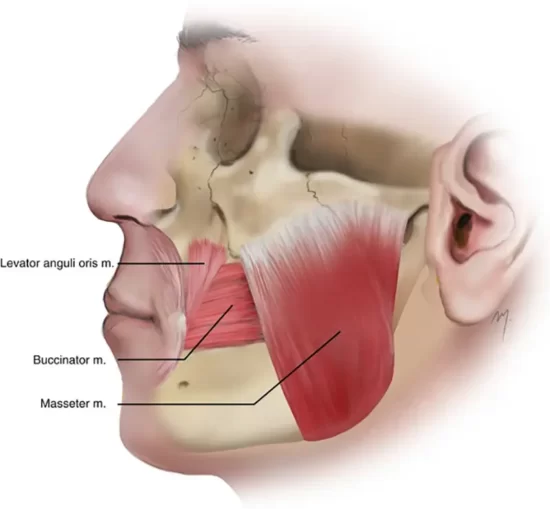
Cheek augmentation and cheek prosthesis implantation
Cheek augmentation is one of the beauty methods used all around the world because cheek protrusion is regarded by people as one of the facial beauty and youth criteria. There are two major events that occur in cheeks with age. First, cheek adipose tissue is partially depleted and makes the cheeks smaller. Second, the face tissues become saggy and the soft tissue on cheeks moves to the lower parts. The soft tissue on the cheek and below the eye migrates downward. In addition to creating unevenness under eyes and making cheeks smaller, this tissue displacement deepens the wrinkles around the mouth (smile line). Among therapeutic methods used to resolve this problem we can refer to cheek surgery and jaw prosthesis implantation. Stay tuned for more information.

The aim of beautifying the middle part of the face is to create a relatively smooth surface on the cheeks and under the eyes and to remove the unevenness caused by aging. To remove this unevenness, sometimes we are required to augment some parts beneath the cheek besides the cheek so that the wrinkles around the mouth (smile line) can be eliminated.
Cheek augmentation is performed by changing two parts of the cheek tissue. In the first part, the hard tissue (bony skeleton) is augmented. In the second part, the soft tissue (coverage on the skeleton) is augmented. The two above mentioned methods can also be used in combination, i.e., both skeleton and the soft tissue can be augmented.
The cheek hard tissue augmentation includes the use of cheek prosthesis. The cheek prosthesis is often inserted via an incision made in the mouth. However, sometimes the selected prosthesis model is in such a way that the insertion had better be done through the temples or lower eyelids. Clients’ demands and the type of surgeries they need concurrently also affect the decision making process.
Cheek soft tissue augmentation is performed via different techniques. Using threads that act like fillers, ready-made gels injection, and fat injection are among the main methods used for cheek soft tissue augmentation and boosting cheek volume. Of all methods used for cheek soft tissue augmentation, only fat injection will be permanent.
Which one is suitable for cheek augmentation: cheek prosthesis or fat and gel injection?
To answer this question, one must pay attention to many things. Paying attention to the degree of protrusion of the facial skeleton and thickness of soft tissue on the facial skeleton contribute significantly to decision making. Two main models of cheek are investigated below:
The first model (the bony part of the cheek is very prominent): Many international mannequins and Hollywood actresses (e.g., Angelina Jolie), and Iranian Cinema actresses (e.g., Hedyeh Tehrani) have very attractive faces due to the bony prominence of their cheeks. One of the characteristics of this model of cheeks is that although the cheeks are small in volume, they show their prominence well. This type of cheek is especially suitable for women with strong animus personality, who are very decisive and charismatic in life. These women have many fans and followers among European and American men. Advocates of such cheeks are recommended to use cheek prosthesis.
The second model (the soft tissue part of the cheek is very prominent): In contrast to the above mentioned cheek type, we see another model in some actresses like Bahareh Rahnama. Among characteristics of these cheeks are the higher volume and thickness of the soft tissue. This type of cheeks is especially proper for women who tend to appear very cute and feminine, and sometimes tend to have a baby face. These women have many fans and followers among men of the Middle East, especially Arab countries (and in Iran in the west and south of the country). Advocates of such cheeks are recommended to augment the cheek soft tissue via fat injection or gel injection for cheeks.
There is a spectrum of different models of cheeks between the two above mentioned main models of cheek. To choose the cheek model that fits you, you need to pay attention to the following items besides the above mentioned materials. 1. Paying attention to proportionality of different facial elements, 2. Personal desires and tastes, and 3. Personality and culture type of where you live in. During preoperative counseling sessions, any client can talk about this issue with the physician and counselors.
In many cases, cheek augmentation, cheek prosthesis or fat injection can be performed simultaneously with the other cosmetic surgeries (e.g., facelift or chin prostheses, etc.).
Silicone prosthesis insertion is very easy and that is why many surgeons recommend it to patients. These prostheses are well-adapted to the body, but as time passes, they absorb their adjacent bone where they are located. Bone resorption causes no problem in most patients, but in some patients it changes the shape of the cheeks over time and rarely leads to chronic facial pain. The silicone prosthesis can be easily removed if it causes any complication or if you are not satisfied with the result.
In order to insert the MEDPOR prosthesis, the surgeon needs to be highly skilled. Moreover, the MEDPOR prosthesis must be reshaped or cut in most people to attain the best results. Therefore, as many surgeons are not skilled to work with MEDPOR prosthesis, and silicone prosthesis insertion is easier for them, most surgeons recommend silicone prosthesis to clients. There are other types of prosthesis, such as Gore-Tex prosthesis, that are not now easily found on the Iranian market.
Different types of cheek prosthesis
Different types of cheek prosthesis can be divided into three main groups. Depending on the face appearance and the client’s demand, different models of one of the following groups are recommended to patients.

Prosthesis in the cheek area (Malar): Malar is a model of cheek prosthesis designed for direct augmentation of cheek bone and is placed directly on the most prominent part of the bone.
Prosthesis in the area below the cheek (Submalar): This model of cheek prosthesis has been designed to augment the area beneath the cheek and the middle part of the face. It is inserted in the area slightly lower than the malar prosthesis. This type of prosthesis is more used in some clients (e.g., marathon runners) whose middle part of the face is small in volume.
Combined prosthesis: This prosthesis is suitable when we aim to augment the cheek and the tissue beneath it at the same time. This type of prosthesis is especially suitable (sometimes in combination with other methods of increasing facial volume) for some clients who are genetically predisposed to excessive facial slimming or lack of growth in the middle part of the face.
Notice: Improper prosthesis form selection can lead to post-surgery dissatisfaction; therefore, in addition to being examined regarding the prosthesis size during preoperative consultation, the clients should be examined by cosmetic consultant and surgeon in terms of the best form of prosthesis that can meet their demands,
There are several ways to insert cheek prosthesis (through the mouth, through the area under the eyes, or through the temples). However, cheek prostheses are often inserted through the mouth as the incision will not be visible after the operation. The operation lasts about one hour. This operation can be performed under general anesthesia or local anesthesia and using deep sleep. The time of recovery from surgery is about one week.
Does cheek prosthesis insertion through the mouth increase the chance of infection?
It was initially thought that the placement of prostheses (e.g., chin, cheek, jaw angle prostheses, etc.) through the mouth further increased the infection chance as compared with external prostheses. Further research showed that the probability of infection risk in both methods is low and equal.
Is there a possibility of asymmetrical cheeks following the cheek prosthesis insertion?
Like any other cheek augmentation method (e.g., gel or fat injection), there is also a possibility of asymmetry in cheeks after cheek prosthesis insertion (cheek surgery). In order to avoid cheeks asymmetry following prosthesis insertion, the physician will make some arrangements. For example, prosthesis fixation on the bone using stitches or screws prevents displacement and asymmetry of the prosthesis post-cheek surgery. One of the reasons for asymmetry following cheek surgery is the lack of attention to previous asymmetries. Note that in most cases, there are cheek asymmetries in ordinary people that are not corrected following the cheek prosthesis insertion and people, who look more carefully at their cheeks post-surgery, think that the asymmetry has just occurred.
Sometimes, asymmetrical swelling is seen on the cheeks post-surgery. In this case, you are ensured that the asymmetry observed in the cheeks will resolve on its own without any therapy.
What alternative methods can be used for cheek augmentation except prosthesis?
Among other methods used for cheek augmentation we can refer to fat injection, gel injection, and using lift threads. As mentioned in this article, these methods augment the cheeks by increasing the volume of soft cheek tissue. Of the cheek soft tissue augmentation methods, facial fat injection has a permanent durability like cheek prosthesis, but the effect of other methods is temporary.
Important and delicate points related to proportionality of cheeks to other facial elements:
- In some cases, buccal fat removal (also known as a buccal lipectomy) can be a complement to cheek prosthesis. The face becomes less attractive in people with soft-tissue thickness and high fat accumulation in the area under the cheek. In these people, buccal fat removal alone can make cheeks more prominent to some extent.
- As we get older, the muscle mass of the cheek is depleted and the prominent angles of the cheek will slowly fade away. We must consider increasing the volume and creating angles in the middle part of the face when we want to rejuvenate the face.
- Besides cheek prosthesis, gel injection and fat injection methods can be used for cheek augmentation and rejuvenation of the middle part of the face and the area below the eye.
- Endoscopic cheek lift can be a suitable choice in people who have a proper cheek volume but suffer from laxity and descent of the cheek for different reasons. Most applicants of this method tend to rejuvenate their cheeks and the area around their eyes and are usually below the age 45-50 years.
Be careful in choosing your surgeon. There have been some cases in which one has gotten complications or problems from improper insertion of a prosthesis on the cheek requiring re-surgery. In the video below, Dr. Bayat explains about this problem.
